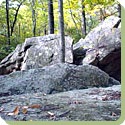 In many parts of the world, you can find large boulders, called erratics, which rest on rocks of a different kind. How did they get there? One idea popular in the early 19th century was that they had been rolled there by strong currents during Noah’s Flood!
In many parts of the world, you can find large boulders, called erratics, which rest on rocks of a different kind. How did they get there? One idea popular in the early 19th century was that they had been rolled there by strong currents during Noah’s Flood!
In the 1830s, a Swiss professor, Louis Agassiz, studied the glaciers, which move slowly down mountains valleys in the Alps. He saw that glaciers carried loose rock (moraine) ranging in size from fine particles of clay to boulders. Could ice, not water, have moved the erratics?
Agassiz finally decided that, at some time in the past, there had been an Ice Age and ice had spread over a much larger area than it does today. The erratics, he argued, were moved at that time. His ideas, published in 1840, finally won the day.
 Kids Portal For Parents India Kids Network
Kids Portal For Parents India Kids Network






